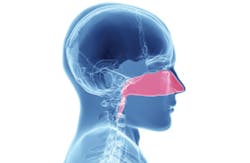What are they:
- Naegleria fowleri are a species of amoeba that live in the natural water environment and some drinking water plumbing. They can be fatal if they enter the nose.
- Amoebas are a class of protozoa that are one-celled animals, as opposed to bacteria, which are closer to plants.
- Protozoa are divided into four major groups: The ciliates, the flagellates, the heliozoans and the amoebas. Amoebas do not have rigid cell walls, so they can readily change shape. The lifecycle of the Naegleria fowleri has three stages that include trophozoite, flagellate and cyst. Trophozoites are the form that is infective to humans.
- Trophozoites turn into a non-feeding flagellate stage (having whip like structures) under adverse conditions, e.g. low food source. Under more adverse conditions they convert into a spherical cyst.
Occurrence and exposure in water:
- Naeglaria can be present, especially in warmer climates, in lake and river waters and hot springs, as well as swimming pools.
- They grow especially well in warm conditions up to 5o F (46o C) and can survive for some time at temperatures above 50o C.
- Exposure occurs from swimming when the head is submerged, or from inhaling water, e.g. when sinus washing.
- They have been occasionally found in treated drinking waters in the U.S. and Australia, and also in biofilms in drinking water plumbing systems.
- They feed on bacteria in their natural environment.
- There are not really good methods to quantify their actual occurrence.
- The Centers for Disease Control and Prevention (CDC) does not recommend testing rivers and lakes for Naeglaria fowleri because "they are naturally occurring and there is no established relationship between their concentrations and risk of infection."
Health effects:
- From zero to eight cases per year are reported in the U.S., although there are potentially millions of recreational exposures each year. So, the risks are small, but the effect is devastating.
- There were two deaths in Louisiana in 2013 from home exposures in two public drinking water supplies. Both deaths were associated with the use of neti pots for nasal irrigation to relieve sinus congestion.
- Naeglaria fowleri infects people when the contaminated water enters the body through the nose. It is not infectious by ingestion. It is the only species of Naegleria known to infect people. It travels to the brain by way of the olefactory nerves and causes an infection called primary meningoencephalitis.
- The first case was identified in the U.S. in Florida in 1962. Retrospective analyses of autopsy tissue samples identified cases that had occurred in Virginia in 1937.
- The infection is essentially always fatal; there was one survivor out of 123 cases in the U.S.
- There is no good medical treatment available. A drug that has been used to treat other amoebic infections is now being considered for Naeglaria infections.
Water treatment:
- The Naeglaria amoeba is rather large at about 10 to 35 µm (bacteria are ~1 or 2 µm long and Cryptosporidium is about 4-6 µm), so conventional drinking water treatment (coagulation, flocculation, sedimentation and disinfection) could be effective. However, since they can change shape they might be able to migrate through some filter media.
- Chlorine, and other primary disinfectants can kill them, but they are resistant.
- Chlorine at 1 ppm at 25o C (77o F) will achieve four logs of reduction of the trophozoites in 12 minutes (CT = 12).
- However, the cyst requires about 53 minutes (CT = 53). That is about the same sensitivity as giardia cysts, but much less effective than chlorine on bacteria or viruses (CT ~6 for virus at 10o C).
Regulation:
- Regulation of the specific organism is probably not feasible, but it is likely that the surface water treatment requirements would be effective for removing most Naeglaria from surface waters.
- So, it would be logical to be very cautious when recreational water, including swimming pool water, or drinking water is entering the nose, either deliberately or accidently. Try to expel it as soon as possible. This is especially important when warm waters are involved.


